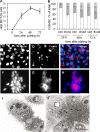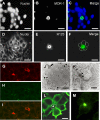Rho kinase, myosin-II, and p42/44 MAPK control extracellular matrix-mediated apical bile canalicular lumen morphogenesis in HepG2 cells
- PMID: 16687572
- PMCID: PMC1552049
- DOI: 10.1091/mbc.e06-01-0067
Rho kinase, myosin-II, and p42/44 MAPK control extracellular matrix-mediated apical bile canalicular lumen morphogenesis in HepG2 cells
Abstract
The molecular mechanisms that regulate multicellular architecture and the development of extended apical bile canalicular lumens in hepatocytes are poorly understood. Here, we show that hepatic HepG2 cells cultured on glass coverslips first develop intercellular apical lumens typically formed by a pair of cells. Prolonged cell culture results in extensive organizational changes, including cell clustering, multilayering, and apical lumen morphogenesis. The latter includes the development of large acinar structures and subsequent elongated canalicular lumens that span multiple cells. These morphological changes closely resemble the early organizational pattern during development, regeneration, and neoplasia of the liver and are rapidly induced when cells are cultured on predeposited extracellular matrix (ECM). Inhibition of Rho kinase or its target myosin-II ATPase in cells cultured on glass coverslips mimics the morphogenic response to ECM. Consistently, stimulation of Rho kinase and subsequent myosin-II ATPase activity by lipoxygenase-controlled eicosatetranoic acid metabolism inhibits ECM-mediated cell multilayering and apical lumen morphogenesis but not initial apical lumen formation. Furthermore, apical lumen remodeling but not cell multilayering requires basal p42/44 MAPK activity. Together, the data suggest a role for hepatocyte-derived ECM in the spatial organization of hepatocytes and apical lumen morphogenesis and identify Rho kinase, myosin-II, and MAPK as potentially important players in different aspects of bile canalicular lumen morphogenesis.
Figures








Similar articles
-
Regulatory subunit I-controlled protein kinase A activity is required for apical bile canalicular lumen development in hepatocytes.J Biol Chem. 2009 Jul 31;284(31):20773-80. doi: 10.1074/jbc.M109.013599. Epub 2009 May 22. J Biol Chem. 2009. PMID: 19465483 Free PMC article.
-
Bile canaliculus formation in cultured HEPG2 cells.Lab Invest. 1993 Jun;68(6):652-62. Lab Invest. 1993. PMID: 8390592
-
Rab11a and myosin Vb are required for bile canalicular formation in WIF-B9 cells.Proc Natl Acad Sci U S A. 2005 Oct 18;102(42):15087-92. doi: 10.1073/pnas.0503702102. Epub 2005 Oct 7. Proc Natl Acad Sci U S A. 2005. PMID: 16214890 Free PMC article.
-
[Regulation of myosin II in cell division and cell migration].Tanpakushitsu Kakusan Koso. 2006 May;51(6 Suppl):566-72. Tanpakushitsu Kakusan Koso. 2006. PMID: 16719313 Review. Japanese. No abstract available.
-
Tissue hydraulics: Physics of lumen formation and interaction.Cells Dev. 2021 Dec;168:203724. doi: 10.1016/j.cdev.2021.203724. Epub 2021 Jul 30. Cells Dev. 2021. PMID: 34339904 Review.
Cited by
-
Role of tight junctions in signal transduction: an update.EXCLI J. 2014 Oct 13;13:1145-62. eCollection 2014. EXCLI J. 2014. PMID: 26417329 Free PMC article. Review.
-
Regulatory subunit I-controlled protein kinase A activity is required for apical bile canalicular lumen development in hepatocytes.J Biol Chem. 2009 Jul 31;284(31):20773-80. doi: 10.1074/jbc.M109.013599. Epub 2009 May 22. J Biol Chem. 2009. PMID: 19465483 Free PMC article.
-
Structural and functional hepatocyte polarity and liver disease.J Hepatol. 2015 Oct;63(4):1023-37. doi: 10.1016/j.jhep.2015.06.015. Epub 2015 Jun 24. J Hepatol. 2015. PMID: 26116792 Free PMC article. Review.
-
Rho-kinase/myosin light chain kinase pathway plays a key role in the impairment of bile canaliculi dynamics induced by cholestatic drugs.Sci Rep. 2016 May 12;6:24709. doi: 10.1038/srep24709. Sci Rep. 2016. PMID: 27169750 Free PMC article.
-
The unique polarity phenotype of hepatocytes.Exp Cell Res. 2014 Nov 1;328(2):276-83. doi: 10.1016/j.yexcr.2014.06.006. Epub 2014 Jun 20. Exp Cell Res. 2014. PMID: 24956563 Free PMC article. Review.
References
-
- Abu-Absi S. F., Friend J. R., Hansen L. K., Hu W. S. Structural polarity and functional bile canaliculi in rat hepatocyte spheroids. Exp. Cell Res. 2002;274:56–67. - PubMed
-
- Araki S., Ito M., Kureishi Y., Feng J., Machida H., Isaka N., Amano M., Kaibuchi K., Hartshorne D. J., Nakano T. Arachidonic acid-induced Ca2+ sensitization of smooth muscle contraction through activation of Rho-kinase. Pflueg. Arch. Eur. J. Physiol. 2001;441:596–603. - PubMed
-
- Bouma M. E., Rogier E., Verthier N., Labarre C., Feldmann G. Further cellular investigation of the human hepatoblastoma-derived cell line HepG 2, morphology and immunocytochemical studies of hepatic-secreted proteins. In Vitro Cell Dev. Biol. 1989;25:267–275. - PubMed
-
- Bertet C., Sulak L., Lecuit T. Myosin-dependent junction remodelling controls planar cell intercalation and axis elongation. Nature. 2004;429:667–671. - PubMed
Publication types
MeSH terms
Substances
LinkOut - more resources
Full Text Sources
Other Literature Sources

